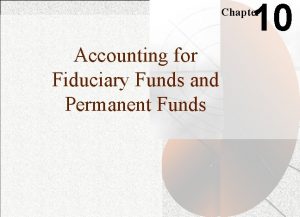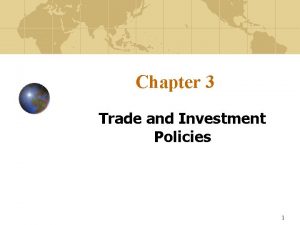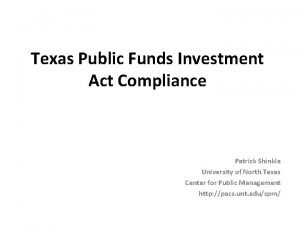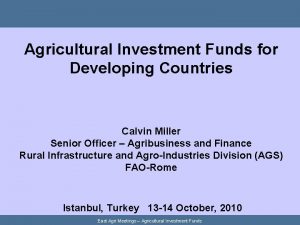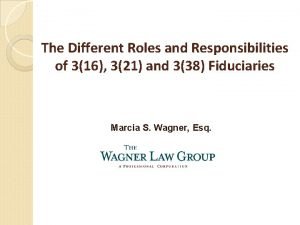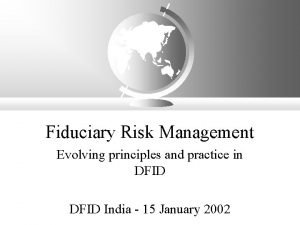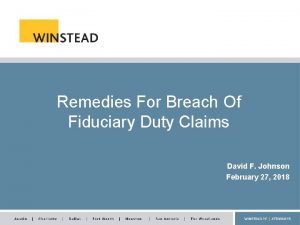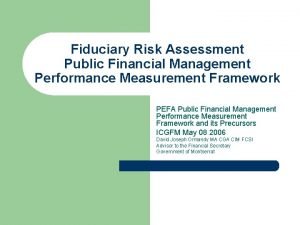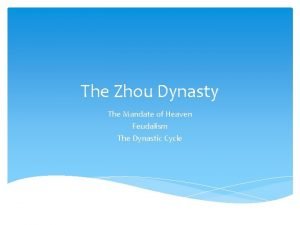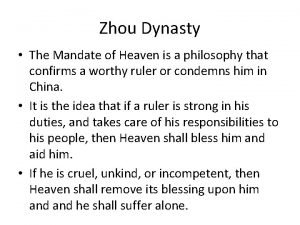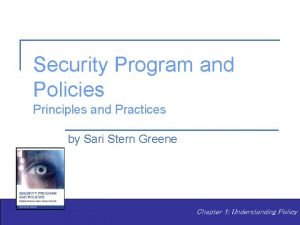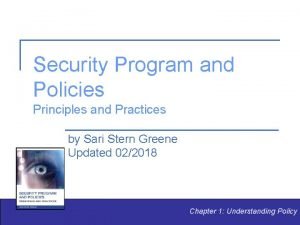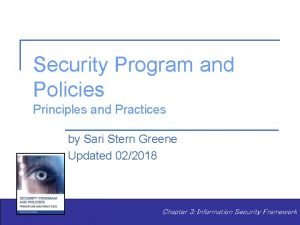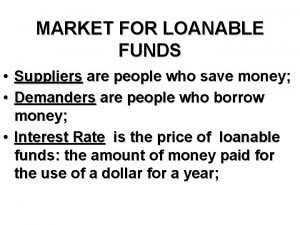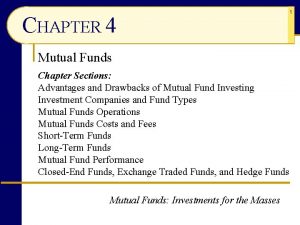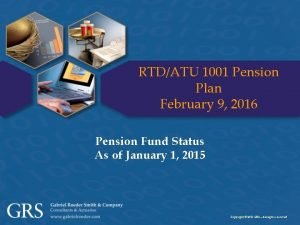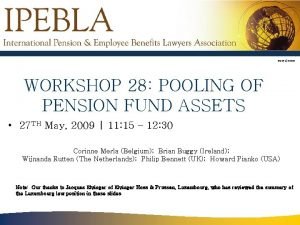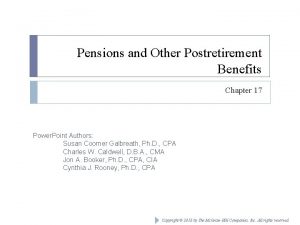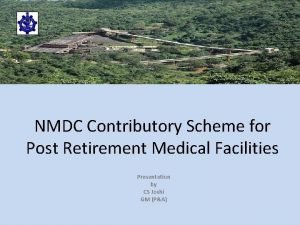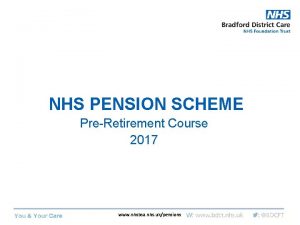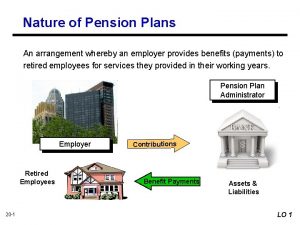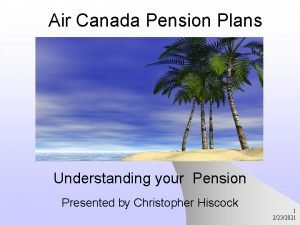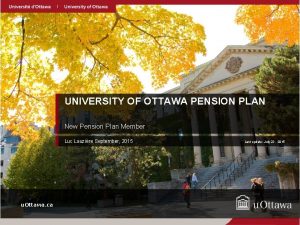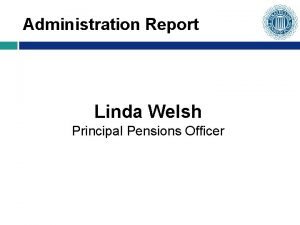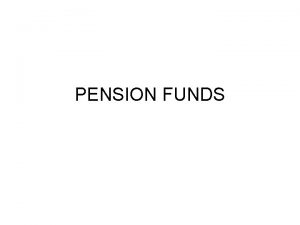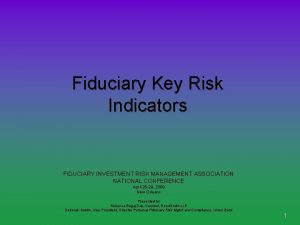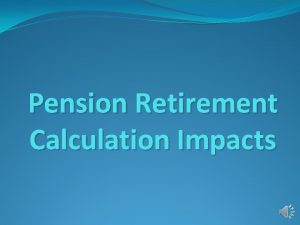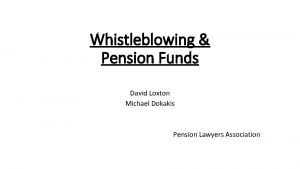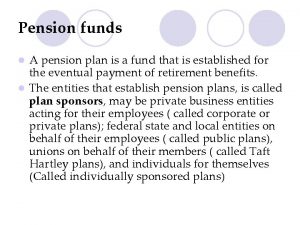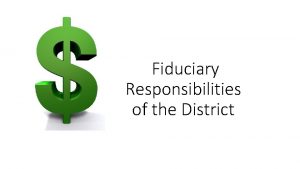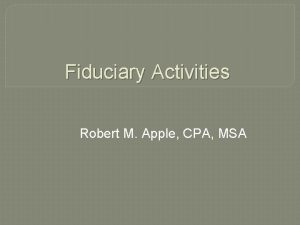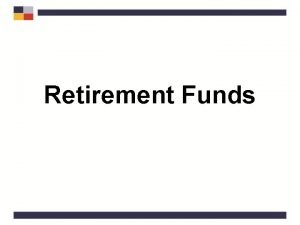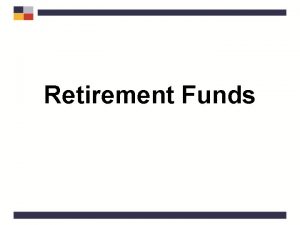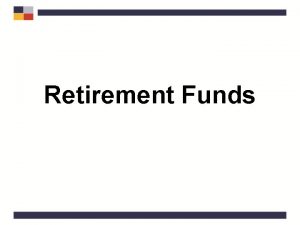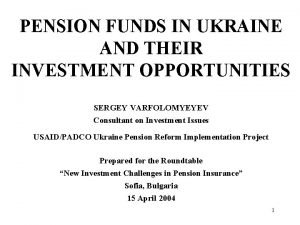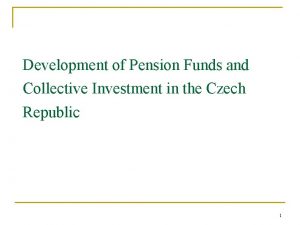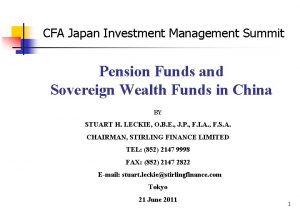Pension Funds Investment Policies CLIENT MANDATE AND FIDUCIARY




























































- Slides: 60

Pension Funds Investment Policies è è CLIENT MANDATE AND FIDUCIARY DUTY TIME HORIZON MAXIMIZATION OF RETURNS RISK DIVERSIFICATION CONCLUSIONS Pension Funds Investing Policies

THE INVESTMENT MANDATE INVESTMENT MANAGER /ADVISOR Market Knowledge Fiduciary Duty Pension Funds Investing Policies

Investment Manager Responsibility Fiduciary Duty: – – – Act in a professional and ethical manner at all times Act for the benefit of clients Act with independence and objectivity Act with skill, competence and diligence Communicate with clients in a timely and accurate manner Uphold the rules governing capital markets. Factors not considered in this presentation: – National Interests – Regulatory risks – Degree of maturity of local investment industry. Pension Funds Investing Policies

Pension Fund Investor’s Needs Goal: – Maintain purchasing power after retirement Mean: – Contributions to pension fund – Build a portfolio as efficient as possible to achieve financial goal Investment Mandate Requirements: – Time Horizon – Required Returns – Risk Tolerance Pension Funds Investing Policies

Purchasing Power: The benchmark is inflation ØThe enemy of the pension investor: INFLATION. Source: Dimson, Marsh and Staunton: The Triumph of the Optimists – London Business School Pension Funds Investing Policies

TIME HORIZON: First step in defining optimal Asset Allocation RISK The first question we need to ask when building an efficient portfolio is the investment horizon in which the contributor is going to save before going into retirement. TIME HORIZON Pension Funds Investing Policies RETURN

Pension Funds Investment Policies è è CLIENT MANDATE AND FIDUCIARY DUTY TIME HORIZON MAXIMIZATION OF RETURNS RISK DIVERSIFICATION CONCLUSIONS Pension Funds Investing Policies

TIME HORIZON: The role of Time ØPension Fund investing is about LONG TERM. ü Long term financial needs ü Long term investing strategy Example – Contributors’ age pyramid in Uruguay For the average contributor, retirement age is more than 25 years away. (Male) Pension Funds Investing Policies (Female)

TIME HORIZON: The role of Time ØThanks for the increased levels of life expectancy, even for the retired person, maintaining purchasing power along their remaining expected life continues to be a long term issue. Spain – Life expectancy at birth 3, 6 more years of pension. . . Source: INE Pension Funds Investing Policies

TIME HORIZON: The importance of just 1% ØOnce we consider very long time horizons, the importance of just 1% additional return can be very significant. Albert Einstein: “Compound interest is the greatest mathematical discovery of all time” Pension Funds Investing Policies

TIME HORIZON: The importance of just 1% ØWhen we are considering long-term time horizons, small differences in return matter. A lot! 36 x 3 x Pension Funds Investing Policies

TIME HORIZON: Magnitude of PP risk ØAt an annual inflation rate of 3%, after 20 years, the investor has lost 46% (1. 00 minus the 0. 54 of remaining purchasing power) o his/her original purchasing power on an investment whose principal value is assumed to remain unchanged. After 1 Year Pension Funds Investing Policies After 5 Yeasr After 10 Years After 20 Years

TIME HORIZON: 1 year versus 5/10 years ØHaving as reference 1 year returns versus longer time references can yield significance differences in returns and in risk perception. 5 Year Reference 10 Year Reference 15 Year Reference 20 Year Reference + 54% Multiperiod Compound Annual Returns, 1926 -2001 + 40% +28, 6% + 21, 6% +20, 1% +15, 6% 0% -2, 0% - 9% - 43% - 12, 5% - 0, 9% - 0, 1% + 18, 9% +13, 5% + 17, 9% +12, 1% +0, 6% +0, 4% +3, 1% +0, 7% Stocks Bonds Source: Stocks, Bonds, Bills and Inflation: 2002 Yearbook, Ibbotson Associates Pension Funds Investing Policies

TIME HORIZON: Conclusions Pensions are about long term planning and investing Ø For the average pension fund investors, the investment horizon is much more long term than investors normally think. (+20 years). Ø Even for the investors approaching retirement, the time horizon continues to be quite long term as life expectancy continues to rise. Ø Pension contributors with different investment horizons should have different investment policies and asset allocations as the tolerance for risk differs substantially. Ø In the long term, a 1% difference in returns implies a significance impact on capital growth. Inversely, a 1% increase in inflation erodes substantially purchasing power over time. Pension Funds Investing Policies

Pension Funds Investment Policies è è CLIENT MANDATE AND FIDUCIARY DUTY TIME HORIZON MAXIMIZATION OF RETURNS RISK DIVERSIFICATION CONCLUSIONS Pension Funds Investing Policies

Nothing ventured, nothing gained. Pension Funds Investing Policies

RETURNS: Climbing the profitability ladder Ø Higher returns are inevitably associated with higher risk (volatility of returns). That risk is mitigated by the fact that the pension investor has on average a longer time horizon. RISK To achieve better returns for our investors, we have to invest in the higher returning assets. TIME HORIZON Pension Funds Investing Policies RETURN

RETURNS: Which asset class to hold to maximise returns? Ø Let’s take a look at historical returns. “The farther backward you can look, the farther forward you can see” – Winston Churchill Pension Funds Investing Policies

RETURNS: Bonds vs Equities Ø Four studies on historical returns: Morningstar / Ibbotson: 1926 -2006 (Center for Research in Securities Prices) Jeremy Siegel: Stocks for the Long Run (1802 -2001) Dimson, Marsh & Staunton (London Business School): 19002002/6 Morgan Stanley Investment Management: 1871 -2000 Assets’ Annual Rates of Return by Economic Environment Pension Funds Investing Policies

RETURNS: Bonds vs Equities – 1) Nominal returns Ibbotson: 1926 -2006 (Center for Research in Securities Prices) Pension Funds Investing Policies

RETURNS: Bonds vs Equities – 2) Real returns Ibbotson: 1926 -2006 (Center for Research in Securities Prices) Pension Funds Investing Policies

RETURNS: Bonds vs Equities – 2) Real returns Jeremy Siegel: Stocks for the Long Run (1802 -2001) Pension Funds Investing Policies

RETURNS: Bonds vs Equities – 2) Real returns Jeremy Siegel: Stocks for the Long Run (1802 -2001) Taken as reference very long periods of time (30 years), equities always have beaten both bond and bill returns. Pension Funds Investing Policies

RETURNS: Bonds vs Equities – 2) Real returns Dimson, Marsh & Staunton (London Business School): 1900 -2002 Source: Elroy Dimson, Paul Marsh & Mike Staunton: Irrational Optimism January 2004 Pension Funds Investing Policies

RETURNS: Bonds vs Equities – 2) Real returns Dimson, Marsh & Staunton (London Business School): 1900 -2002 Source: Elroy Dimson, Paul Marsh & Mike Staunton: Triumph of the Optimists (101 Years of Global Investment Returns) Pension Funds Investing Policies

RETURNS: Which asset class beats inflation? Morgan Stanley Investment Management: 1871 -2000 Assets’ Annual Rates of Return by Economic Environment Source: Morgan Stanley Investment Management & David M. Darst (“The Art of Asset Allocation”) Pension Funds Investing Policies

RETURNS: Which asset class beats inflation? Morgan Stanley Investment Management: 1871 -2000 Assets’ Annual Rates of Return by Economic Environment Ä Housing and Equities provide returns that either match or beat inflation in any economic climate, while bonds suffer significantly on inflationary environments. Source: Morgan Stanley Investment Management & David M. Darst (“The Art of Asset Allocation”) Pension Funds Investing Policies

RETURNS: Conclusions (BONDS) Ø Bonds provide certainty of nominal returns, a high degree of capital protection, but very poor purchasing power protection. Ø As a result of the devastating effects of inflation, in many countries bonds have failed to provide positive real returns during the past century. Source: Elroy Dimson, Paul Marsh & Mike Staunton: Triumph of the Optimists (101 Years of Global Investment Returns) Pension Funds Investing Policies

RETURNS: Conclusions (BONDS) ØTaken as a whole, the last century has not been especially kind to bond investors. In the United States, the annualized real return on long-term government bonds was 1, 6%. While this was 0, 7% higher than on bills, bonds had much higher risk. In five countries, (Germany, Italy, Japan, France and Belgium). BONDS – Accumulated real returns (1900 -2000) Source: Elroy Dimson, Paul Marsh & Mike Staunton: Triumph of the Optimists (101 Years of Global Investment Returns) Pension Funds Investing Policies

RETURNS: Conclusions (EQUITIES) ØIn every study and country examined, equities have beaten bonds, bills and inflation over the long haul. This outperformance is not simply a pattern from the past; it is consistent with theory that riskier securities should command a lower price than safer ones. ØRisky equities can, therefore, be expected to offer a higher expected return. For risk-tolerant investors, that makes equities a desirable long-term investment. EQUITIES – Accumulated real returns (1900 -2000) Source: Elroy Dimson, Paul Marsh & Mike Staunton: Triumph of the Optimists (101 Years of Global Investment Returns) Pension Funds Investing Policies

RETURNS: Conclusions Nothing ventured, nothing gained. Ø Pension fund investors require REAL returns. Ø Historical analysis determine the following real returns ranges: • 2 - 8% for Equity • -2% - 3% for Bonds Ø Bonds do not provide shelter against inflationary scenarios. An increase in long term inflation expectations could have very negative effects on conservative portfolios tilted towards fixed income. ØReal returns are offered by “real” assets (equities, property, private equity, infrastructure. . . ). Pension Funds Investing Policies

Will the future resemble the past? ØMark Twain: “Forecasting is very difficult, especially when it concerns the future” Pension Funds Investing Policies

Pension Funds Investment Policies è è CLIENT MANDATE AND FIDUCIARY DUTY TIME HORIZON MAXIMIZATION OF RETURNS RISK DIVERSIFICATION CONCLUSIONS Pension Funds Investing Policies

Don’t put all your eggs in one basket. Pension Funds Investing Policies

RISK ØThe perception that human beings are naturally risk-averse seems obvious enough. Nevertheless, the literature on investing up to 1952 had either ignored the interplay between risk and return or had treated it in the most casual manner. John M. KEYNES: “Diversification is an admission of not knowing what to do, and an effort to strike an average” Pension Funds Investing Policies “Unfortunately, the markets can remain irrational longer than you can remain solvent. I advise damage control”

RISK ØIn 1952, a 25 year-old graduate student from the University of Chicago published a short paper titled “Porfolio Selection”. Markowitz analyzed the choices facing an investor who must decide between seeking high returns and attempting to hold down risk at the same time. Harry M. Markowitz: “I was struck with the notion that you should be interested in risk as well as return” Pension Funds Investing Policies Albert Einstein: “Insurance is one of humanity’s most brilliant inventions”

Reminder: What type of RISK? RISK: Not volatility but purchasing power risk ØInvestor’s tolerance for risk can vary substantially from one person to another, and within the same person, from one financial market environment to another, or from one time period to another. ØIronically, for the long-term investor, volatility of returns is not the primary risk: instead the major risk is the diminution of purchasing power from the long-term erosive effects of consumer price inflation. Pension Funds Investing Policies

RISK: Minimizing the impact of negative scenarios Ø In a mandate that requires purchasing power protection and capital growth, risk cannot be eliminated but it certainly can be reduced through appropriate diversification strategies. RISK TIME HORIZON Pension Funds Investing Policies Risk reduction mandate without sacrificing all returns expectations RETURN

RISK: Minimizing the impact of negative scenarios Ø Economists teach “there ain’t no such thing as a free lunch. ” While explicit and implicit costs permeate the field of economics, financial markets contain a marvelous exception. Ø Harry Markowitz, pioneer of modern portfolio theory, maintains that portfolio diversification is that exceptional free lunch. By combining assets that vary in response to forces that drive markets, well diversified, more efficient portfolios can be created. Ø At a given risk level, properly diversified portfolios provide higher returns than less well-diversified portfolios. For a given return level, well-diversified portfolios produce returns with lower risk. Pension Funds Investing Policies

RISK: Worst case scenario: It happens. . . Ø EQUITIES: Examples of the most dramatic equity market environments, with an illustration of the worst affected countries. Pension Funds Investing Policies

RISK: Worst case scenario: It happens. . . Ø EQUITIES: Japanese investors who decided not to diversify have seen their investments reduced by more than half after 27 years. Japan Equities: NIKKEI Index -55% nominal returns after 27 years. Source: Bloomberg Pension Funds Investing Policies

RISK: Worst case scenario: It happens. . . Ø BONDS: Japanese investors have not yet recovered from the devastating effects of inflation after the Second World War. Source: _____ Pension Funds Investing Policies

RISK: Worst case scenario: It happens. . . Diversification works because owning more than one asset protects the investor from the contingency that everything will be lost at one fell swoop. Pension Funds Investing Policies

RISK: International diversification ØIn the most volatile markets, like in Japanese equites, investors have had to wait nearly 50 years in the worst scenarios to recover real purchasing power. Pension Funds Investing Policies

RISK: International diversification ØIncreasing the number of countries in the portfolio from one to five decreases substantially the risk (standard deviation) between 15% and 30%. The manager has a duty to protect investments against very negative scenarios (those with a high standard deviation). 20. 3 Pension Funds Investing Policies Source: _____

RISK: International diversification ØEven considering scenarios of 20 year returns, there are periods in certain countries in which the investors have had negative real returns (nearly zero risk in the World equity portfolio). Source: Dimson, Marsh and Staunton: Irrational Optimism – Financial Analyst Journal Feb 04 Pension Funds Investing Policies But with a highly diversified portfolio that downside risk is diminished.

RISK: International diversification ØUndiversified stocks cannot be regarded as safe in real terms even when the investor has a horizon of 20 years or more. With a diversified portfolio that risk is nearly eliminated. Pension Funds Investing Policies

RISK: Asset Class diversification ØWhich asset class is going to deliver the best/worst returns in the next 5 years? As this is so hard to foresee, it makes sense to diversify among different asset classes. Pension Funds Investing Policies

RISK: Asset Class diversification ØThe case for investing in small caps and emerging markets is reflected in their superior historical returns performance. Pension Funds Investing Policies

RISK: Asset Class diversification ØREAL ESTATE and INFRASTRUCTURE also are investments that can add value over a long term period as they can diversify risk and also increase returns. Risk and Return Expectations, 30 September 2005 Source: Roger Urwin: “Asset Allocaton in a low-return environment. Pension Funds Investing Policies

RISK: Asset Class diversification ØCORPORATE BONDS have behaved above Government Bonds as could be expected as a result of the default risk premium of the private sector issuers. Pension Funds Investing Policies

RISK: Asset Class diversification ØPRIVATE EQUITY returns are difficult to calculate, but most statistics show returns above or similar to equities. Recent returns have been very strong providing a great incentive for fund raising in this asset class. Pension Funds Investing Policies

RISK: Asset Class diversification ØHEDGE FUNDS: Its attractiveness as an asset class lies in its low correlation with markets and attractive historical returns, as illustrated by Optimal’s (Santander AM specialized hedge fund unit) funds returns. Pension Funds Investing Policies

Benefits of Diversification: Yale endowment ØThe results of the Yale University endowment are a good example of the benefits of diversification. David Swensen (CIO) and his team have been able to obtain great returns diversifying among the most profitable asset classes in the long term. Pension Funds Investing Policies

To diversify diminishes risk but does not maximize returns. ØDiversifying risk does not mean that all portfolios should be overweight in developed economies. Investing in emerging economies provides great potential for enhanced returns. Source: MSCI Pension Funds Investing Policies ?

Conclusions: Duty to diversify risk ØTo invest implies an assumption of risk. Some of this risk can’t be diversified away but some can through different mechanisms: üInternational diversification diminishes the potential negative outcomes of exposure to a country with very negative returns. üAsset Class diversification allows the investor protection against concentration on assets behaving very poorly. ØDIVERSIFICATION: One “free lunch” is still available in the investment world – risk reduction through international diversification. Investment risk is lowered in a worldwide portfolio. Global investors can therefore afford to allocate relatively more of Øtheir Global investors can therefore afford allocate Since relatively more of portfolio to risky assets, such asto equities. riskier assets their risky assets, as equities. Sinceportfolios riskier assets offer portfolio a positivetoreward for risk, such investors’ worldwide have offer a positive reward forinrisk, investors’ portfolios have a higher expected return relation to theirworldwide risk. a higher expected return in relation to their risk. Pension Funds Investing Policies

Pension Funds Investment Policies è è CLIENT MANDATE AND FIDUCIARY DUTY TIME HORIZON MAXIMIZATION OF RETURNS RISK DIVERSIFICATION CONCLUSIONS Pension Funds Investing Policies

Conclusions ØPension Fund Investing is about LONG TERM ØTIME HORIZON: Investors with longer time horizons should have a different asset allocation policy than workers approaching retirement. ØRETURNS: Investors requirement is to achieve returns above inflation. To protect purchasing power it is needed to invest in “real” assets (equity, private equity, real estate. . . ). Equities are more suitable than bonds to hedge against the effect of rising inflation. ØRETURNS: On the long run, equities have outperformed bonds in every single country. However, in the short term equities can have significant downside. ØRISK: The portfolio manager has a duty to diversify in every possible way (internationally and in different asset classes) in order to reduce the impact of possible downside scenarios. Pension Funds Investing Policies

World Bank Pension Fund Recommendations ØGovernments have a responsibility to ensure that pension funds earn decent returns for their members, especially when contributions are mandatory. ØExplicit and implicit guarantees of pension values mean governments also have a financial interest in promoting good pension fund performance. ØThis responsibility has been used to justify strict regulation of pension funds’ portfolios, the fund management industry’s structure and investment returns. ØBut these restrictions have a cost, as liberal investment regimes have had better pension fund returns than those with strict regulations. ØLiberalizing the pension fund market should offer better returns, increased competition between funds and allow workers to choose a portfolio that matches their individual circumstances. Pension Funds Investing Policies

World Bank Pension Fund Recommendations Pension Funds Investing Policies
 Accounting for fiduciary funds
Accounting for fiduciary funds Income under the head salary
Income under the head salary Key risk indicators template
Key risk indicators template Fiduciary investment risk management association
Fiduciary investment risk management association Trade and investment policies
Trade and investment policies Public funds investment act training
Public funds investment act training Calvin miller coltivare
Calvin miller coltivare Fixed investment and inventory investment
Fixed investment and inventory investment Vmatrix server manager
Vmatrix server manager Client lourd vs client léger
Client lourd vs client léger Example of two tier architecture
Example of two tier architecture Responsibilities
Responsibilities Va fiduciary hub lincoln nebraska
Va fiduciary hub lincoln nebraska Fidelity trust services fee schedule
Fidelity trust services fee schedule Fiduciary risk management
Fiduciary risk management Va fiduciary field examination
Va fiduciary field examination Fox rothschild fiduciary attorney summit
Fox rothschild fiduciary attorney summit Breach of fiduciary duty remedies
Breach of fiduciary duty remedies Fiduciary risk assessment
Fiduciary risk assessment What is the mandate of heaven and the dynastic cycle
What is the mandate of heaven and the dynastic cycle Zhou dynasty feudalism
Zhou dynasty feudalism Which dynasty introduced the mandate of heaven?
Which dynasty introduced the mandate of heaven? Security program and policies principles and practices
Security program and policies principles and practices Bsbhrm506 assessment answers
Bsbhrm506 assessment answers Security program and policies principles and practices
Security program and policies principles and practices Security program and policies principles and practices
Security program and policies principles and practices Security program and policies principles and practices
Security program and policies principles and practices Security program and policies principles and practices
Security program and policies principles and practices Sources and uses of funds
Sources and uses of funds Shareholders equity and shareholders funds
Shareholders equity and shareholders funds Who are the demanders of loanable funds
Who are the demanders of loanable funds Shifters of demand for loanable funds
Shifters of demand for loanable funds Advantages and disadvantages of closed end funds
Advantages and disadvantages of closed end funds Kebutuhan dana untuk aktiva tetap
Kebutuhan dana untuk aktiva tetap Sppa pension
Sppa pension Rtd/atu 1001 pension plan
Rtd/atu 1001 pension plan Pension master trust
Pension master trust How to calculate pension expense
How to calculate pension expense Nmdc pension scheme
Nmdc pension scheme Www.totalrewardstatements.nhs.uk
Www.totalrewardstatements.nhs.uk Jim1 nhs monthly
Jim1 nhs monthly Nhs pension examples
Nhs pension examples Accuaries
Accuaries Mbao pension plan balance
Mbao pension plan balance Edad de jubilacion decimo transitorio
Edad de jubilacion decimo transitorio Hsc pensions
Hsc pensions Hsc pension calculator 1995
Hsc pension calculator 1995 Kpa pension föräldramöte
Kpa pension föräldramöte Tabla pension issste
Tabla pension issste Air canada hr connex
Air canada hr connex Aviva group personal pension
Aviva group personal pension Ntpc ex employees prms
Ntpc ex employees prms Benefits of pension plans
Benefits of pension plans Caricature russe europe
Caricature russe europe Bsnl sampann
Bsnl sampann Pension planner northamptonshire
Pension planner northamptonshire Portalq
Portalq Pension planning cambridgeshire
Pension planning cambridgeshire Cambridge pension
Cambridge pension Spfo pension
Spfo pension Bel retired officers association bangalore
Bel retired officers association bangalore
